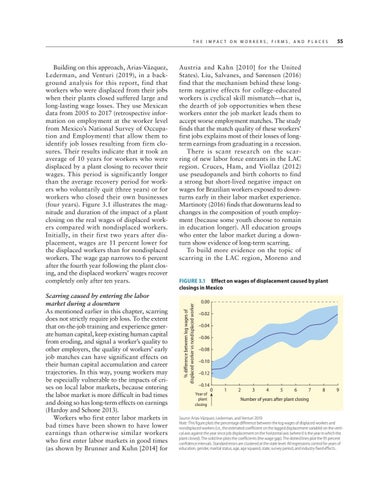T h e I m p ac t o n W o r k e r s , F i r m s , a n d P l ac e s
Scarring caused by entering the labor market during a downturn As mentioned earlier in this chapter, scarring does not strictly require job loss. To the extent that on-the-job training and experience generate human capital, keep existing human capital from eroding, and signal a worker’s quality to other employers, the quality of workers’ early job matches can have significant effects on their human capital accumulation and career trajectories. In this way, young workers may be especially vulnerable to the impacts of crises on local labor markets, because entering the labor market is more difficult in bad times and doing so has long-term effects on earnings (Hardoy and Schone 2013). Workers who first enter labor markets in bad times have been shown to have lower earnings than otherwise similar workers who first enter labor markets in good times (as shown by Brunner and Kuhn [2014] for
Austria and Kahn [2010] for the United States). Liu, Salvanes, and Sørensen (2016) find that the mechanism behind these longterm negative effects for college-educated workers is cyclical skill mismatch—that is, the dearth of job opportunities when these workers enter the job market leads them to accept worse employment matches. The study finds that the match quality of these workers’ first jobs explains most of their losses of longterm earnings from graduating in a recession. There is scant research on the scarring of new labor force entrants in the LAC region. Cruces, Ham, and Viollaz (2012) use pseudopanels and birth cohorts to find a strong but short-lived negative impact on wages for Brazilian workers exposed to downturns early in their labor market experience. Martinoty (2016) finds that downturns lead to changes in the composition of youth employment (because some youth choose to remain in education longer). All education groups who enter the labor market during a downturn show evidence of long-term scarring. To build more evidence on the topic of scarring in the LAC region, Moreno and FIGURE 3.1 Effect on wages of displacement caused by plant closings in Mexico % difference between log wages of displaced worker vs nondisplaced worker
Building on this approach, Arias-Vázquez, Lederman, and Venturi (2019), in a background analysis for this report, find that workers who were displaced from their jobs when their plants closed suffered large and long-lasting wage losses. They use Mexican data from 2005 to 2017 (retrospective information on employment at the worker level from Mexico’s National Survey of Occupation and Employment) that allow them to identify job losses resulting from firm closures. Their results indicate that it took an average of 10 years for workers who were displaced by a plant closing to recover their wages. This period is significantly longer than the average recovery period for workers who voluntarily quit (three years) or for workers who closed their own businesses (four years). Figure 3.1 illustrates the magnitude and duration of the impact of a plant closing on the real wages of displaced workers compared with nondisplaced workers. Initially, in their first two years after displacement, wages are 11 percent lower for the displaced workers than for nondisplaced workers. The wage gap narrows to 6 percent after the fourth year following the plant closing, and the displaced workers’ wages recover completely only after ten years.
55
0.00 –0.02 –0.04 –0.06 –0.08 –0.10 –0.12 –0.14 Year of plant closing
0
1
2
3
4
5
6
7
8
9
Number of years after plant closing
Source: Arias-Vázquez, Lederman, and Venturi 2019. Note: This figure plots the percentage difference between the log wages of displaced workers and nondisplaced workers (i.e., the estimated coefficient on the lagged displacement variable) on the vertical axis against the year since job displacement on the horizontal axis (where 0 is the year in which the plant closed). The solid line plots the coefficients (the wage gap). The dotted lines plot the 95 percent confidence intervals. Standard errors are clustered at the state level. All regressions control for years of education, gender, marital status, age, age squared, state, survey period, and industry fixed effects.

